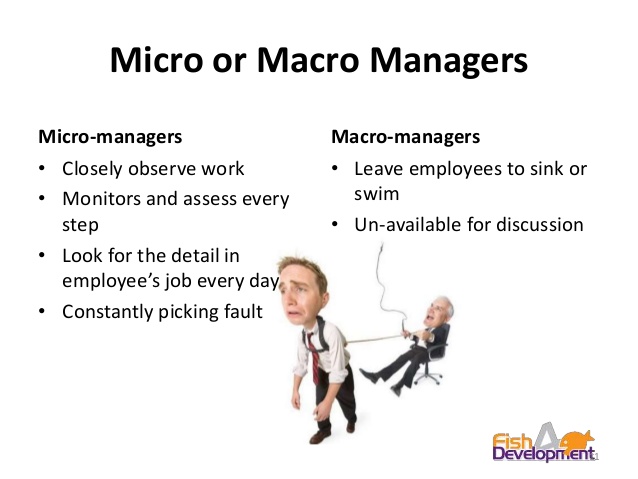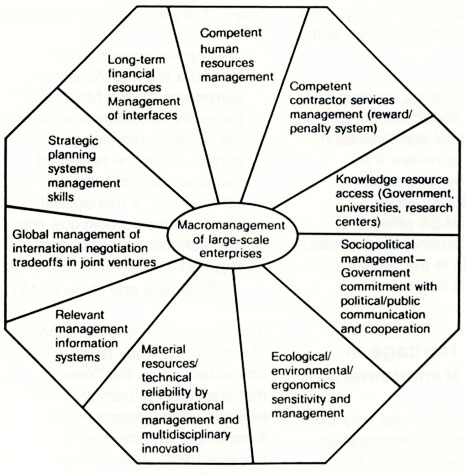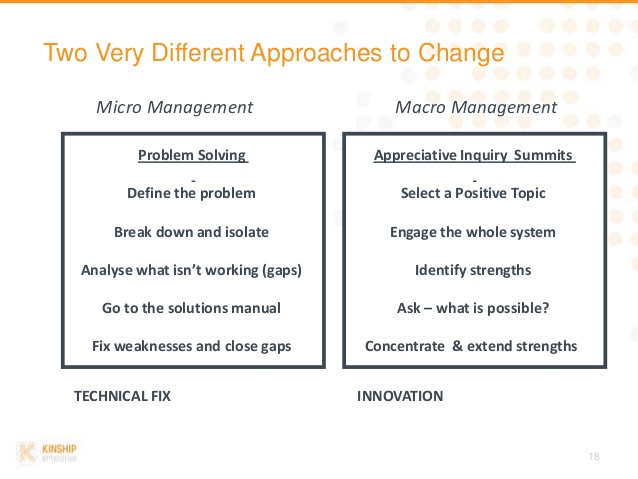In our last newsletter, we have considered micro-management, its causes, its consequences and the possible therapies. While most people are familiar with the term and its non-business connotation, very few are aware of the other extreme of the spectrum: macro-management.
Macro-management is the management style by which the manager lets her/his subordinates do their jobs with minimal supervision.
> Sounds good?
The extremes are seldom good practices!

Is macro-management positive or negative then?
> Even though allowing employees freedom to act within their job requirements and their personal abilities is considered the most effective management style, it may not be that simple!
*********
Macro-managers allow their employees too much freedom and this comes at a price:Lack of connection and alignment
If a manager is more often than not absent from the workplace or in any case her/his employees see very little of her/him, then the team fails to feel and behave as a team. The team members may also lose their connection to the rest of the organization, as the connecting link is broken. Prolonged periods of absence may also lead to misalignment from corporate mission and values.
Lack of guidance
While part of the workforce will be too happy to be left practically unsupervised, this is not true for all employees. There is a number of them who need support and often require to revert to their boss for guidance, confirmation or decision. If the manager is not available then they remain unsure of which route to choose.
Lack of problem solving
The same applies for problem solving. Even though one of the most important tasks of a manager is to assist his/her people in solving their work-related problems, the macro-manager believes that his subordinates should find ways to solve their issues by themselves and is in no way concerned with these.
Lack of control
Not all people who prefer loose supervision are competent and creative. Whereas some will be motivated by this management style and will thrive within the freedom established, others will take advantage of the situation and lay back, becoming unproductive or even damaging to the organization. The macro-manager may not realize soon enough if such cases exist and may lose control of who actually gets any work done.
Lack of ownership
A manager who is disengaged from her/his people and their needs, who does not periodically monitor their results, is in no position to understand where her/his department is heading in terms of corporate targets or employee morale.
*********
What is the result of macro-management?Not surprisingly, macro-management has similar results with micro-management, for exactly the opposite reasons.
> Employees feel abandoned and stressed and eventually become demotivated.
> In contrast to the micro-management scenario, employees may not feel the pressing urge to leave the team, especially if their manager does not hold them accountable for mistakes, low performance or inefficiency.
> This means, of course, that even if they stay with the organization, they will have a tendency to do less and less.
> They may not report being totally unsatisfied but they will become a burden to the organization.
> Demotivation and lack of guidance and problem solving will lead to low team results.
> Problems will remain pending longer than they should, solutions will be inadequate, the line of action disputable.
> Unless all team members are overachievers and thrive despite the absence of support, the overall results of the department will drop.
> Since the team becomes increasingly detached from the rest of the organization, they miss the big picture and they evidently drift from corporate values and targets. Corporate cohesion is impaired.
*********
Why would a manager be a macro-manager?As we have seen with micro-managers, a person may adopt this management style either due to his/her lack of management skills or due to his/her personality or due to both.
> Newly appointed managers may find it difficult to draw the line between allowing their employees the liberty to act as they wish and losing control. They may therefore adopt a macro-management style in their attempt not to suffocate their people, especially if they have been their peers for a long period of time - a rather common situation, especially, in the governmental domain!
> In other occasions, a manager may macro-manage by necessity, if he/she has taken up too much work or too many projects and he/she finds it impossible to cope with the workload.
> The third type is the person who, by nature, believes that she/he must not waste her time with day to day management, but would rather be engaged in “higher level” activities. This person is a macro-manager by choice.
There exist also persons, who are both micro and macro managers at the same time! These individuals, while macro-managers in general, may slip into micro-management mode occasionally, if triggered by something such as a project they particularly like or an employee they particularly dislike. These may be equally detrimental to the organization!
*********
What to do with macro-managers?
The remedies for macro-management are similar to those of micro-management and as we have already discussed, they include training, coaching and occasionally letting go of people who bring in their wake higher cost than benefit for the organization.
*********
Can macro-management be put into good service?
All these said, we need to acknowledge that macro-management is useful as a "corporate management" concept (as the following example shows) but not as a "managerial" one!

Finally, an extremely -and rather rare- versatile manager may use both managerial styles depending on the situation as the following diagram shows - in managing change:

Do remember:
Management style depends on the type of business and corporate culture. While some types of organizations, such as research centers, may benefit from a (structured) macro-management style, most will suffer. It is therefore important to find the optimum management style, somewhere in between: based on ongoing communication, employee initiative and management support.
3.6.2016


